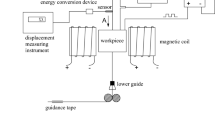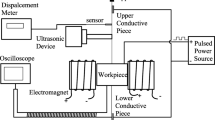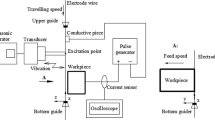Abstract
The shape of the gap is narrow and thin in low-speed wire electrical discharge machining (WEDM-LS) workpiece with large thickness; it is likely that a lot of debris cannot be removed out of the gap in time, or even accumulate somewhere, which causes a poor machining stability and low processing efficiency. In this paper, ultrasonic vibration (USV) and magnetic field (MF) complex–assisted techniques are combined with WEDM-LS to improve the machining performance. The velocity and pressure of the flow field in USV-assisted WEDM-LS are analyzed according to the theory of fluid mechanics. The fluid-solid coupling model of electrode wire and working fluid, the two-phase flow model of the working fluid, and the debris are established in COMSOL Multiphysics software, and the influence of different amplitudes on motion and distribution of debris is analyzed. It is indicated by the simulation results of debris motion that the exclusion rate of debris increases by 22.5% and the debris are distributed more evenly in the discharge gap. The experiment of a USV-assisted WEDM-LS machining workpiece with large thickness is conducted. It shows that the probability of abnormal electrical discharge reduces obviously and the distribution of discharge point is more uniform, which increases the pulse utilization and discharge efficiency. In addition, the material removal rate (MRR) increases by 44.4%, the surface roughness value (Ra) reduces by 12.8% on average, the number of debris recast to the surface decreases significantly, and the micro-cracks on the machined surface of the workpiece decrease in USV-assisted WEDM-LS.




























Similar content being viewed by others
Data availability
The manuscript has no associated data or the data will not be deposited.
References
Ho KH, Newman ST, Rahimifard S, Allen RD (2004) State of the art in wire electrical discharge machining (WEDM). Int J Mach Tools Manuf 44(12-13):1247–1259
Fan SY, Zhang QJ, Chen HW, Zeng WX (2013) Nonlinear dynamics analysis of multi-cutting wire electrode in WEDM-HS subjected to working fluid considering the effect of debris. J Mech Sci Technol 27(12):3595–3605
Zhang Z, Huang H, Ming WY, Xu Z, Huang Y, Zhang GJ (2016) Study on machining characteristics of WEDM with ultrasonic vibration and magnetic field assisted techniques. J Mater Process Technol 234:342–352
Pan HW, Liu ZD, Li CR, Zhang YQ, Qiu MB (2017) Enhanced debris expelling in high-speed wire electrical discharge machining. Int J Adv Manuf Technol 93(5-8):2913–2920
Chen ST, Yang SW (2017) A high-density, super-high-aspect-ratio microprobe array realized by high-frequency vibration assisted inverse micro w-EDM. J Mater Process Technol 250:144–155
Li XP, Wang YG, Liu Y, Wang H, Zhao FL (2019) Research on shape changes in cylinder electrodes incident to micro-EDM. Adv Mater Sci Eng 2019:8587462
Wang Y, Wang Q, Ding Z, He D, Xiong W, Chen S, Li Z (2018) Study on the mechanism and key technique of ultrasonic vibration and magnetic field complex assisted WEDM-LS thick shape memory alloy workpiece. J Mater Process Technol 261:251–265
Liu Y, Chang H, Zhang WC, Ma FJ, Sha ZH, Zhang SF (2018) A simulation study of debris removal process in ultrasonic vibration assisted electrical discharge machining (EDM) of deep holes. Micromachines 9(8):378
Mastud SA, Kothari NS, Singh RK, Samuel J, Joshi SS (2014) Analysis of debris motion in vibration assisted reverse micro electrical discharge machining. proceedings of the ASME 9th International Manufacturing Science and Engineering Conference. VOL 1
Zhang Z, Yu HS, Zhang YM, Yang K, Li WY, Chen Z, Zhang GJ (2018) Analysis and optimization of process energy consumption and environmental impact in electrical discharge machining of titanium superalloys. J Clean Prod 198:833–846
Fard RK, Afza RA, Teimouri R (2013) Experimental investigation, intelligent modeling and multi-characteristics optimization of dry WEDM process of Al-SiC metal matrix composite. J Manuf Process 15(4):483–494
Azhiri RB, Teimouri R, Baboly MG, Leseman Z (2014) Application of Taguchi, ANFIS and grey relational analysis for studying, modeling and optimization of wire EDM process while using gaseous media. Int J Adv Manuf Technol 71(1-4):279–295
Haas P, Pontelandolfo P, Perez R (2013) Particle hydrodynamics of the electrical discharge machining process. Part 1: physical considerations and wire EDM process improvement. Procedia CIRP 6:41–46
Okada A, Uno Y, Onoda S, Habib S (2009) Computational fluid dynamics analysis of working fluid flow and debris movement in wire EDMed kerf. CIRP Ann-Manuf Technol 58(1):209–212
Ji YC, Liu ZD, Deng C, Fang LJ, Qiu MB (2019) Study on high-efficiency cutting of high-thickness workpiece with stranded wire electrode in high-speed wire electrical discharge machining. Int J Adv Manuf Technol 100(1-4):973–982
Wang M, Wang R (2006) Analysis of forces acting on abrasive particles in abrasive water jet. J Univ Petroleum China (Edition of Natural Science) 4: 47-49+74
Rajurkar KP, Pandit SM (1986) Formation and ejection of EDM Debris. J Eng Ind 108(1):22–26
Lee MH (1989) The rationale of electric discharge machining. China Industrial Press:358–359
Liu Y, Cao FG, Gui XB, Zhang QJ (2008) Research on the mechanism of material erosion based on explosion force in EDM. Electromachining Mould 5:19–25
Funding
The authors would like to thank the Natural Science Foundation of Shanghai for its support for this study.
Author information
Authors and Affiliations
Contributions
Yan Wang: Conceptualization, methodology, supervision, writing—review and editing. Yongxin Wang: formal analysis, visualization, writing—original draft, software programming. Wei Xiong: resources, data curation. Huayi Chai: visualization preparation, writing—review and editing.
Corresponding author
Ethics declarations
Ethical approval
Neither the manuscript nor any part of its content has been published or accepted elsewhere. It’s not being submitted to any other journal as well.
Consent to participate
Not applicable
Consent to publish
Not applicable
Conflict of interest
The authors declare no competing interests.
Additional information
Publisher’s note
Springer Nature remains neutral with regard to jurisdictional claims in published maps and institutional affiliations.
Rights and permissions
About this article
Cite this article
Wang, Y., Wang, Y., Xiong, W. et al. Study on motion and distribution of debris in USV-MF complex–assisted WEDM-LS. Int J Adv Manuf Technol 116, 667–683 (2021). https://doi.org/10.1007/s00170-021-07466-9
Received:
Accepted:
Published:
Issue Date:
DOI: https://doi.org/10.1007/s00170-021-07466-9




